
by DharamCW | Oct 10, 2022 | General
A Project Management Office (PMO) is a group or department within an organization that defines and maintains project management standards. It provides project management guidelines and standards. In addition, it aids in developing measurable objectives that align with the organization’s overall vision and ensure that all targets are met. PMO will also be referred to as a program or project portfolio management office, depending on the project/program/portfolio.
The Project/Program/Portfolio office has undergone a paradigm shift during this COVID-19. This shift has also paved the way for innovative ways of its operations and leads us to the question of revisiting gaps PMOs have from the context between where we are today and how the future holds for the PMO. Project managers/portfolio managers need to embrace today’s PMO situation and be ready for transformation in the days ahead. There could be challenges and opportunities that need prioritizing. This article helps to envisage the gaps between PMOs of today and PMOs of the future.
PMO Types
PMOs are based on their degree of control and influence on projects. Of the many types, there are three distinct types of PMO.

3 Distinct Types of PMO
- Supportive: A supportive PMO gathers all of an organization’s projects and provides best practices, templates, and training but with limited control.
- Controlling: A controlling PMO ensures that project management tools, processes, and standards are implemented in a controlled manner.
- Directive: Within the organization, a directive PMO maintains a high level of control over the project management process.
In 2020 according to the Wellingtone Survey, 89% of organizations reported having at least one PMO.
Role of PMO
Project Office was the term used for aircraft development in the 1930s by the U.S. Air Corps. PMO has been widely adopted since the 1980s when it was first adopted in Construction and IT and slowly adopted in other sectors. It added value and efficiency to the projects and programs through better management. PMO was considered a central administrative office responsible for setting up standard project management methodologies, processes, guidelines, and templates for project teams.
Besides that, PMO extended the arms in training the teams involved in a project about project management practices. Essentially, they imparted knowledge on appropriate project management practices, which helped team members be on the same page on project management practices. They maintained and tracked the lessons learned risks, and project progress, integrated the data between projects, helped share common resources across projects, and ensured project alignment to the business’s strategic objectives. They have been acting more like a center of excellence for Project Management.
Steps to be taken when developing a PMO strategy
- Clarify your company’s goals, vision, and mission.
- Take note of the resources required for a successful operation.
- Choose the best mode of communication.
- Create a system for tracking progress.
- Create a process for resolving conflicts and overcoming project bottlenecks.

Steps to be taken when developing a PMO strategy
Situation today
In the White Paper: The Future of PMO by Aled Laugharne, Chaucer, states that:
- PMOs operating in the “traditional” way continue to meet stakeholder expectations in around 80% of cases and are considered critical to the program’s success.
- Governance, reporting, planning, and exceptions are all areas where PMOs excel.
- At present, achieving Level 2 – Foundational is sufficient to meet key stakeholder expectations. However, moving to Level 3 – Advanced increases the likelihood of PMOs being marked as “exceeding.”
- Although employers entirely staff some PMOs, consultants and contractors continue to play an important role in PMOs.
- The wider program community is typically less satisfied with PMO performance than key stakeholders who sit centrally.
- In general, there is a 50:50 split between PMOs that believe they need to prioritize improvement and those that want to maintain the status quo or have other program priorities.
Current Potential positive and negative impacts of PMO
The Covid-19 pandemic was the primary driver under External Impacts. However, the consequences of the current crisis appear destined to shape the future of PMO. The following are examples of potential positive and negative consequences:
- Cost-cutting in pandemic-affected industries has resulted in a shift in PMO resourcing to internal staff.
- Change and transformation occur due to the pandemic’s response, increasing the demand for PMO, such as in the Life Sciences industry.
- As a result of virtual working, the need for online collaboration tooling for PMOs is growing.
- With co-location in the country no longer required, virtual working increases global competition for PMO services.
- The rise of Agile PMOs is designed to respond quickly to changing external conditions.
Organizations have started looking to PMOs to optimize the management of increased projects. PMO is responsible for managing delays, cost overruns, quality, and style of the project management practices. Also, they have been involved in resource utilization and accountable for cost-overruns in the projects. It is no more just an administration or supportive role but has become pivotal in strategic and tactical operations across projects.
Today’s PMO in large organizations has an influential role to play. More than being supportive, it has become directive and controlling for compliance and alignment towards organizational objectives. In some organizations, PMOs operate at Strategic Business Unit level or Vertical in alignment with specific sectors with a key focus on Planning, Support, Monitoring, and control functions.
PMO office is involved in providing consistent templates, resources, and tools consistent across projects. Provides an integrated project management capability across the projects and facilitates collaboration in cross-department aspects to align and meet strategic business goals. The tools used and recommended by the PMO are based on Technology, Ease of adoption, price benefit, and ability to scale. Their results directly reflect upon the organization’s operational and resource challenges. Today’s PMO organization helps in who will use the tool, which will maximize benefit, impact on the PMO process, how readiness in terms of adoption, etc.,
Not to mention the problems of meeting deadlines, cost, scope, and quality. There are other areas where PMOs have to evolve; we will discuss some challenges faced by today’s PMOs.
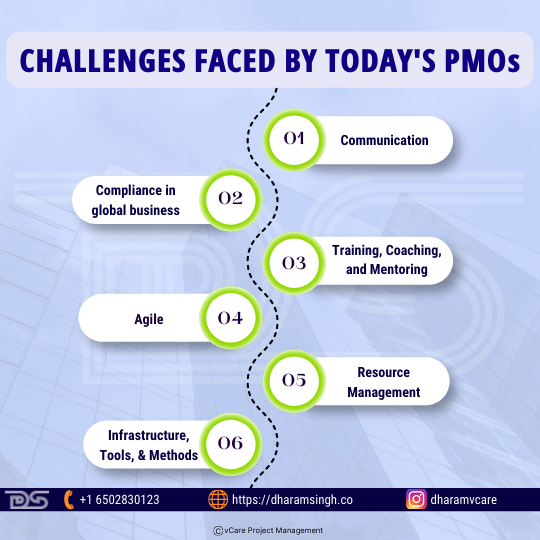
Challenges faced by today’s PMOs
Communication: As an organization has become more digital, the information required by different stakeholders and different levels requires varied contexts. Communication gaps still affect the sponsors or stakeholders due to the availability of information to act on time with the right context. As businesses are so quick to change and environment is dynamic, and priorities change frequently, the PMO must align and adapt quickly.
Compliance in global business: Organizations are no more local. Small or big organizations are starting to have global access thanks to digital. Compliance with organization standards or government regulations when operated across multiple countries. Non-Compliance could turn out to be very costly. Varied and fast changes in procedures/processes would be an additional burden in implementation. Also, cultural factors/time zones would matter when the PMO office is central and not decentralized.
Training, Coaching, and Mentoring: PMOs have to do different things apart from typical training methodologies with project managers/portfolio managers and project associates. When the domain changes, Project managers struggle to cope with these situations. PMO has to help the project manager with an appropriate strategy of training. Ability to track with leading indicators of the training rather than measuring the lagging metrics.
Agile: Large enterprises and organizations are already adopting agile. Requirements are evolving, and project managers don’t have the luxury of having absolute clarity. Yet PMO needs to help the project teams to bring clarity amidst ambiguity, managing assumptions, the definition of done, prioritization, etc. The problem-solving methods have to be made simple and deliver faster decision-making.
Resource Management: Minimizing resource waste is a key function for PMOs, and nowadays, organizations have sustainability goals that will naturally transpire to the PMOs along with project goals. Better planning and coordination are required apart from minimizing risks and managing unforeseen circumstances like COVID. For example, there was a sudden spike for Laptops for resources who are expected to work from home on projects.
Infrastructure, Tools, and Methods: PMO office teams need the right infrastructure in terms of Data, Compute, and more to process data effectively. Current PMO is empowered with tools, predominantly BI and Excel. In the given context of speed of data growth, those tools may not be sufficient. Stronger tools may be required for predictive analytics. Also, the methods are evolving, and the means to collaborate effectively must happen through effective training and other means.
The PMO is evolving into a more strategic role
PMO might focus more on canceling weaker projects. A well-planned project cancellation will free up staff for higher-priority projects. In addition, it makes sense to detect failure early and take appropriate action before the damage worsens. This action contributes to the future cultural shift required for successful project failure.
What holds the future for Tomorrow’s PMO?
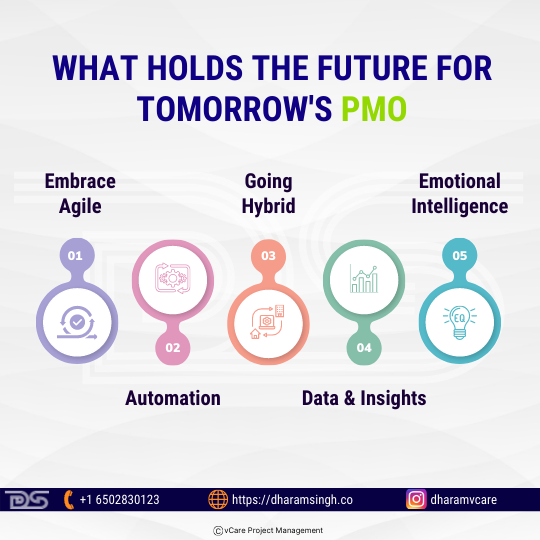
What holds the future for Tomorrow’s PMO
PMO will hold the forte of what matters for the business. They will own the projects and drive results for the organization. In a world where business and IT are more intertwined, the Role of PMO will act as a glue that bonds them together well. PMO will no longer be a support function but will be infused into the business as a core strategy. They will demand that X is needed for Y to be achieved, and this will drive the business objectives and momentum.
Embrace Agile: It has been more than 20+ years since the agile manifesto was released, and the PMO will be more flexible than ever. Organizations are adopting Agile Pods (Product Oriented Delivery) which are a group of small self-organized people with varied skills focused on bringing on the results in development. PMOs will work through this pod and manage the resource pool dynamically based on the project demands with cross-functional awareness. Adopting agile methods by PMOs will result in faster delivery timelines and a more collaborative approach to satisfy stakeholders from a 360-degree perspective. This kind of approach will create a more adaptable PMO function that can be reused and adapted as the PMO function expands its horizons.
Automation: Leverage automation to enhance the speed of delivery. PMOs must identify opportunities for improvement on routine tasks that can be automated. Focus on automating report generation and automation. We need to use the means of notification based on the criticality of the issues to the respective stakeholders. Leverage AI and bots to respond to common queries on the PMO through manual means at enterprise levels. Leveraging automation and AI would help free up critical time for the PMO office to focus on the organization’s strategic goals, act as an enabler to focus on project blockers, and help mobilize resources to resolve bottlenecks in critical paths.
Going Hybrid: By leveraging the tools which can help collaborate better, all the project-related tasks, resources, and people are brought to one place. Teams with varied skills, styles, and different views work together irrespective of place to bring more stability, engagement, and efficiency. Flexible work schedules would also help attract talent and broaden the options which are boundaryless. This freedom also allows the PMO to explore all the options in engaging or onboarding resources required for bringing good results.
Data & Insights: The ability to gain insights from the data is the trend as the data volume is moving from GB to TB. There are heterogeneous data sources beyond organizations that are more external and are to be analyzed through API and SDKs with other systems for meaningful inferences. Data getting converted information and the PMOs responsibility to forecast and identify risks with the knowledge gained through insights will be crucial for the organization. Information insights have to be obtained in less time to act upon it. Integration of communication channels and making it more flexible on push/pull gives the right balance to act upon the information.
Emotional Intelligence: Projects are made of people. People are dealt with emotions daily. Beyond cost, quality and scope, the project managers have to manage the people’s vital resources in the project with care in the times of higher attrition. Striking balance between the millennials and their expectations is crucial, which can be managed through appropriate emotional intelligence management. Managing it would result in handling pressure, making better decisions, strong relationships, and positively impacting the work environment.
Although stakeholders are generally satisfied with current PMO performance, there is a sense that PMOs will need to do the following in the coming years:
- Increase their role in strategic elements of a program, transformation, or organization while decreasing the time spent on transactional processing.
- Increase your tooling and automation, which will allow you to de-scale and facilitate remote working in the “new normal.”
- Organize themselves to quickly “spin up” to support transformations and change the PMO approach as needed.
- Play a bigger role in fusing the “traditional” PMO approach with Agile working methods.
- When establishing and changing the PMO approach, prioritize stakeholder engagement, especially for the larger stakeholder community, and plan specific change activities.
Evolution of PMO – Today & Tomorrow
The PMO’s role might keep changing, but the concept of bridging the gap between today and future PMOs is learning from failures.
- PMOs lose sight of the strategy and become mired in tactical or administrative tasks.
- PMOs maintain a project portfolio that contains gaps, overlaps, and other waste.
- PMOs add processes rather than simplifying or eliminating them.
- PMOs believe that tools will solve all of their problems – or that the flashiest tools will solve all of their problems.
- Even when they provide value, PMOs fail to communicate it.
- PMOs waste too much time on meaningless – or bad – reporting.
- PMOs do not track what is essential or hold people accountable.
- PMOs do not optimize or provide transparency into resource utilization.
- PMOs behave more like police officers than aid workers.
- PMOs either cannot find their place in an agile world or resist it.
As per PMI research, more than 55 percent of PMO directors say the charter for their PMO has changed in the past five years as the impact of technology on PMO is dynamic. The PMO, as part of the organization, is affected by this disruption without exception.
Some examples of the technology used in PMO and its impacts:
- Cloud – 66%
- Digitalization – 54%
- Artificial Intelligence (AI) – 25%
- Internet of Things (IoT) – 24%
- Blockchain – 11%
Conclusion
Transformational PMO needs to learn quickly and must embrace digital disruption. The experts in the domain of PMO have to implement their tools wisely. A new generation of PMOs will be strategic enablers, bridging the gap between a company’s vision and how that vision comes to life. Future PMOs could be virtual or Hybrid. If you are setting up your PMO today, consider all the technical and digital options available on the cloud to use it best. These options would help manage Strategic, Tactical, and operational levels. Include that in your budget. This budgeting would also bring on Collaboration and Transparency. The high use of PPM-Portfolio/Program Management Tools would be crucial for larger organizations. PMO is no more an organization of assigning tasks and monitoring them; it’s well beyond boundaries.
Feel free to check out my discussion on this topic with Thomas Walenta in YouTube.
You can subscribe and follow my podcasts and interviews with Project Management Experts on YouTube at https://bit.ly/2NDY8wd
You can subscribe to vCare Project Management YouTube Channel to catch future videos of our certification Q&A series and student success stories using the link https://bit.ly/2YF0wJl
For any questions related to Project Management career, training, and certifications, you can book an obligation free 15 minutes session with me by visiting talktodharam.com
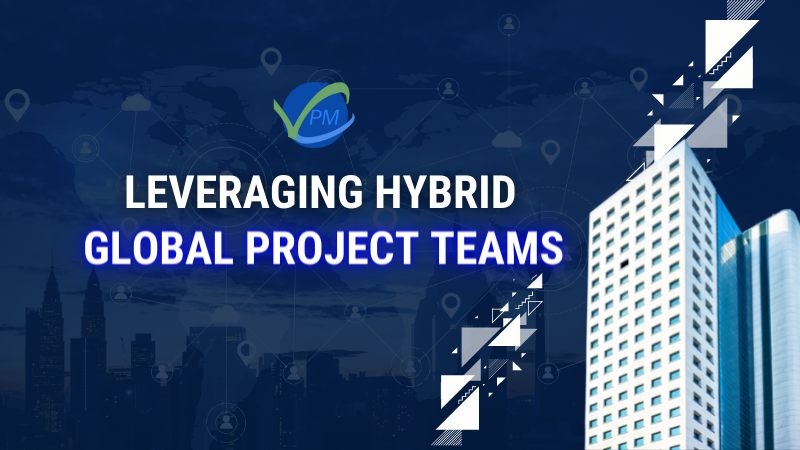
by DharamCW | Jul 8, 2022 | General
COVID-19 has greatly accelerated the digital transformation across various industries. Hybrid work has become the new norm, visibly seen in the hybrid cloud adoption of up to 20% and a decrease in utilization of on-premises workload by 13%. These statistics indicate that more companies trust cloud-based deployments, and organizations are inclined towards such trends.
Global hybrid project teams
Hybrid global teams adopt hybrid work. This adoption could be more defined as a flexible model with a blend of in-office, remote and on-the-go work approaches. The key focus of this model is to provide more autonomy for employees to be productive wherever they work. Such a move would enable team members to migrate between choices of various locations depending on the work which needs to get done.
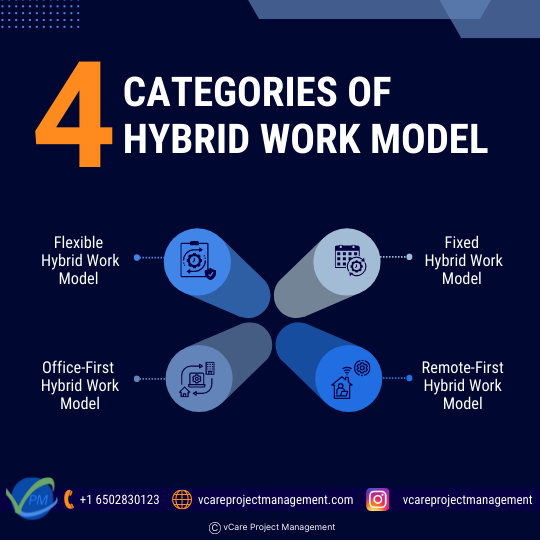
4 categories of hybrid work model
These are typically categorized into
a) Flexible hybrid work model – Where employees choose their work location and hours. This model would provide more autonomy and expands the talent pool and diverse thinking, yet it would be difficult for employers to plan capacity.
b) Fixed Hybrid work model – Employees would plan their days and workplace well ahead, or work would be in the office on predetermined days. Such planning might allow in-person collaboration and increases the opportunity for better planning yet would minimize the lack of choice for individuals.
c) Office-first hybrid work model – In this model, a specified number of days are to be worked in the office, and for the rest of the days, they can choose to work remotely. This model gives flexibility to individual choices and maintains company culture and community, yet it would be challenging to understand and manage individual work plans.
d) Remote-First hybrid work model – In this model, the employees are asked to make remote work a priority and occasionally visit the office for training and collaboration. This model would minimize office space and help reduce costs for employers, though employees might feel isolated.
Typical characteristics of Hybrid Team(s):
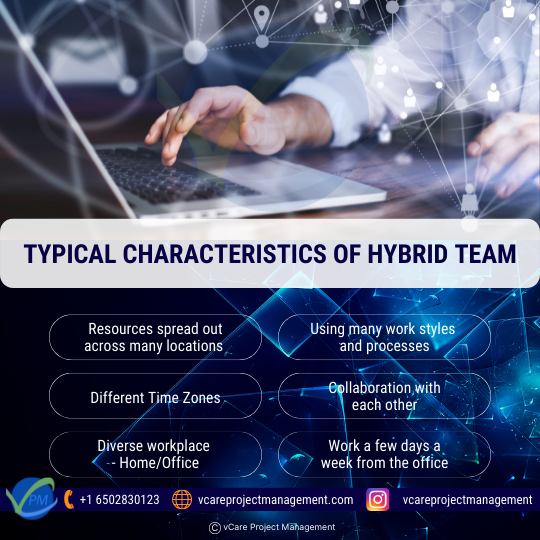
Typical characteristics of Hybrid Team
– Resources spread out across many locations
– Using many work styles and processes
– Different Time Zones
– Collaboration with each other
– Diverse workplace – Home/Office
– Work a few days a week from the office
Current Scenario
- As per the work index trend 2022 report, already, hybrid work is up to seven points year-over-year (to 38%), and 53% of people are likely to consider transitioning to a hybrid workplace in the year ahead
- As per the report from “globalnewswire. in”, nearly 90% of project teams work in multiple locations, with 48% in multiple locations in one country and 39% in many countries.
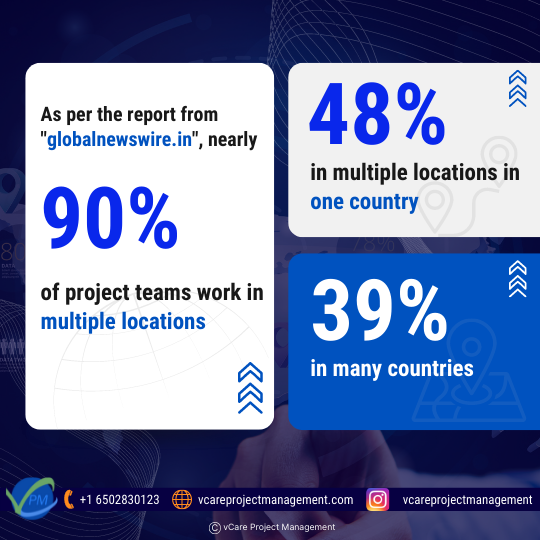
Current Scenario
A Global Survey of Executives, Employee Experience Experts, and Knowledge Workers, Dimensional Research | October 2020
The above paper examines research that sought to understand the impact of COVID-19 on the workplace, the current state of remote workers, their concerns about returning to the office, and the role technology can play in assisting businesses in their transition to the hybrid workplace.
Working from Home, the New Normal
- 58% will work eight or more days each month from home (post-COVID)
- 98% of meetings will include participants joining from home (post-COVID)
- 98% share frustrations with video meetings when working from home
Employees Uncomfortable Returning to the Office
- 97% of employees want changes to make them feel safer at work
- 99% of companies are planning sweeping changes to the workplace as a result of COVID-19
- 94% of companies say the technology would benefit them by providing a safer work environment
Hybrid Work Environment
- 77% of larger organizations will increase work flexibility while 53% will shrink office sizes
- 89% of employees cite frustrations with in-office experiences
- 96% indicate they need intelligent workplace technology to improve work environments

A Global Survey of Executives, Employee Experience Experts, and Knowledge Workers
Leveraging benefits of Hybrid Global Teams
Offices are changing. We are seeing trends of safety/wellness right from the security gate. We are getting into the norm of seating arrangements based on social distancing, touchless elevators, improved ventilation, etc. While we see this increasing trend in hybrid global project teams, we will discuss the benefits and further aspects of the same in detail:
Flexibility and Autonomy
For some, the flexibility mantra is “get connected and get work done from anywhere.” The hybrid scenario is, “why don’t you get to the office and get some work done.” In reality, based on research, flexibility goes beyond that. The members of global hybrid teams are looking for autonomy where they decide when to work from home and when to work from the office. Global project managers understand these expectations and start engaging in models with HR and Administration teams to enable the same. When there is an insistence on specific days or mandates for a specific work location, teams feel stressed, and it becomes an intrinsic threat. Yet, people desire to have in-person connections when they want to work on engagements where there is ambiguity and a need for a physical product or engineering-related aspects. So there are always scenarios that the project or program manager needs to understand and enable an appropriate inclusive approach.
Ease of Collaboration
When there is a clear need to provide flexibility and autonomy to the hybrid teams, it would be fostered and managed through good means of communication. The collaboration tools enable seamless communication with clearly laid guidelines. The guidelines would help set common ground among peers, reporting managers, and clients without going overboard. The tools for collaboration must be standardized and consistent examples of using one tool across the organization must be adhered to.
Inclusive hybrid meetings should occur with onsite/off-site teams across multiple GEOs without opting out. Setting expectations about response times and which communication tools team members should use is critical in reaping the benefits of collaboration. Identify multiple communication channels, including text messaging, video conferencing, or voice calls. Leverage them appropriately, based on the guidelines set. Provide necessary training to enable the team members to determine when to use what. Evaluate needs for increased adoption of tools like JIRA, Monday.com, and Asana for tracking project activities with absolute milestones and timelines. Establish remote-based activities to ensure retaining cultural aspects of the organization beyond work.
Operational Cost
A global talent pool through remote working would help cut operational costs significantly. Fewer people in the workplace means you have reduced unused space, and obviously, you will get financial benefits when you move to a smaller office or use it for different purposes. This move might, in turn, reduce rentals, energy costs, media usage costs, etc. It might also foster creativity in creating a dynamic workplace resulting in better space utilization, further saving costs in terms of fuel for the employees or travel for commuting to the office. Employees are open to selecting the place of liking with less operational cost to work, creating cost-effective and better hybrid teams.
It’s also imperative for the HR, administration, and IT Infrastructure team to enable the hybrid work environment by providing support on a reliable internet connection, providing access to collaboration tools, enhanced and responsive help desk, collaboration on files, and minimizing the needs for multiple access credentials for different applications by enabling single sign-on, etc.,
Meeting Team member’s needs
Hybrid work models minimize the absences/leave from work for trivial needs or minor issues at home. In case of minor/negligible health issues, employees continue to work from home without affecting the office environment, allowing them to heal themselves and continue performing with the tiniest impact on their health. It allows situations like a single mother or father to take care of a sick kid and provides flexibility to attain a good work-life balance. This kind of work model provides a sense of safety and belonging to the employer, not to repeat that moving out of this option might pose a threat regarding retention issues to HR.
Tracking projects in Hybrid global project teams:
As per the new Global Trends in Project Management 2022 report, there are a few challenges in managing projects in today’s hybrid world.
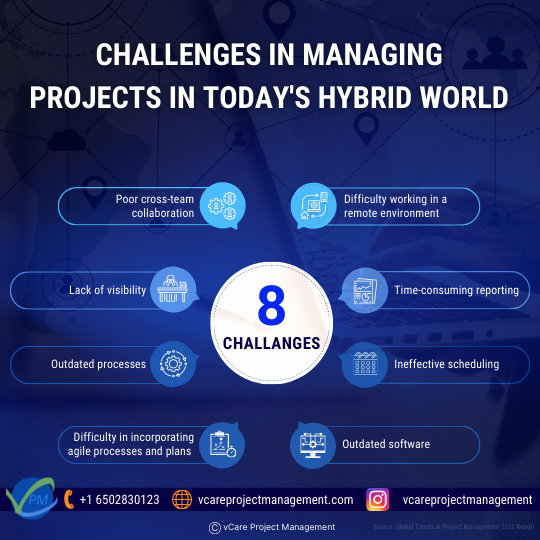
Challenges in managing projects in today’s hybrid world
- Poor cross-team collaboration
The hybrid team is highly likely to split into many groups like the “us vs. them” mentality. So the relationships between co-workers turn too formal, and many traditional opportunities for relationship-building between team members may fail. In addition, it’s more difficult to maintain close friendships with poor cross-team collaboration in hybrid work culture.
- Difficulty working in a remote environment
Working from various locations, time zones, and cultural differences may affect the team’s coordination. These significant factors can create substantial challenges among the team in a remote environment, including managing projects, remote collaboration, task tracking, and productivity.
- Lack of visibility
Information sharing in hybrid teams is frequently uneven and may create miscommunication among the team. This aspect may lead to a lack of visibility, and disparity creates an irrelevant information hierarchy among team members. Hybrid teams should be aware of the problem among the team and set ground rules to ensure that the issues are sorted out consistently.
- Time-consuming reporting
The hybrid work culture will likely affect the team’s productivity. According to many studies, remote workers work only a few hours daily and spend their free time on social media. This phenomenon means that, despite the best efforts, hybrid teams certainly don’t impose the best time in management practices.
- Outdated processes
Outdated processes are more than an annoyance that impedes a company’s day-to-day operations. They become ingrained in your company’s identity, creating impassable trenches between departments, causing team dissatisfaction and inefficiency, and jeopardizing overall success.
- Ineffective scheduling
Poor project planning and scope creep are the leading causes of hybrid team failure. Project managers either lack an overview of all tasks and milestones or struggle during unanticipated schedule changes that affect overall delivery timelines.
- Difficulty in incorporating agile processes and plans
It will be challenging to create a hybrid work culture that blends Agile and traditional plan-driven project management principles and practices in the right proportions to fit a given situation. But doing so takes a lot of skill and understanding how to balance the two can be crucial to success.
- Outdated software
Hybrid workers also spend an hour or more per week dealing with technical issues, saying they aren’t well-supported when troubleshooting problems. In addition, it may lead to a loss of productivity. Forcing employees to use outdated technology and providing insufficient support may result in an organizational brain drain.
How the project manager should equip to handle these challenges?
The project manager has to identify areas where there is a need for physical presence. Explain the dynamics to respective peer members on the need for certain individuals to be in the office for work. For example, the projects that need physical access to the Lab, teams working on embedded products available only in office locations due to client restrictions, etc., a right mix has to be identified, such as fully remote, full onsite, or a combination of both. Project managers should also focus on the schedules considering the global teams involved.
These kinds of challenges mentioned above lead to miscommunication or misinterpretations. Clarity needs to be brought in between the project manager and team members in the hybrid global teams’ perspective with the help of well-established communication guidelines. Clarity will avoid confusion and promote efficiency. Project managers need to be trained on hybrid scenarios and tools essential to managing better. They need to get exposure to project management tools, collaboration tools, and IT Infrastructure setup such as VPN, remote access, etc. concerning collaboration tools or using tools for virtual meetings – aspects like Polls, Hand raise, and Q & A options to collaborate better.
Maximize the opportunity of meeting at a physical workplace to clear the air on certain issues and make the best use of time to increase clarity on project goals and open issues. Establishing feedback loops while implementing the hybrid global project models is important. The project managers need to ask for feedback from the team. Leveraging surveys and getting additional details on feedback and implementation would be very handy.
With hybrid work, whether employees’ desires have changed?
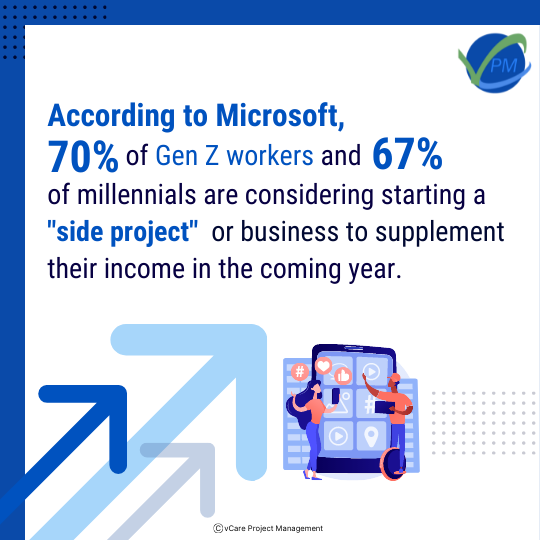
According to Microsoft
“Perks like free food and a corner office are no longer what people value most,” Microsoft says.
Instead, a positive culture (chosen by 46 percent of survey respondents), mental health and well-being benefits (42 percent), and a sense of purpose or meaning are the top things workers want from an employer, aside from a good salary (40 percent). Flexible hours are also highly regarded.
Creativity is becoming increasingly important, and more employees seek to design their jobs around it. According to Microsoft, 70% of Gen Z workers and 67% of millennials are considering starting a “side project” or business to supplement their income in the coming year.
Summary
Hybrid global project teams present challenges and opportunities for the project managers, demanding prudent strategy and pragmatic planning. It is time for project managers to exhibit leadership skills by understanding hybrid models deeper. After all, projects are run by people, and the team needs to stay on course to deliver value to all the stakeholders.
Feel free to check out my discussion on this topic with Thomas Walenta in YouTube
You can subscribe and follow my podcasts and interviews with Project Management Experts on YouTube at https://bit.ly/2NDY8wd
You can subscribe to vCare Project Management YouTube Channel to catch future videos of our certification Q&A series and student success stories using the link https://bit.ly/2YF0wJl
For any questions related to Project Management career, training, and certifications, you can book an obligation free 15 minutes session with me by visiting talktodharam.com
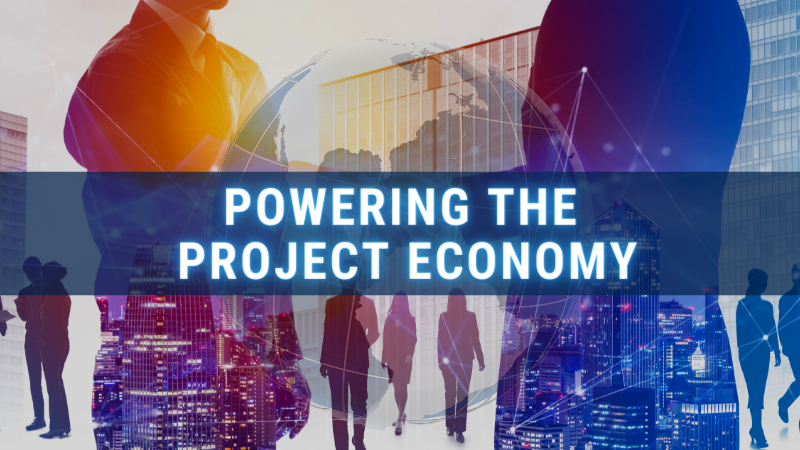
by DharamCW | May 20, 2022 | Project-Program-Portfolio Management Knowledge
Ideas into Reality
People have the skills to work on projects, but they need to be channelized across multiple projects. These skills are the ones that help in the success of the projects. In the end, the people’s skills and capabilities in the project serve to turn ideas into reality. That is when the project delivers value to its stakeholders. The people are the enablers for the growth and transformation of the projects. Ideas can be converted into reality by achieving the right mix of skills and capabilities in people.
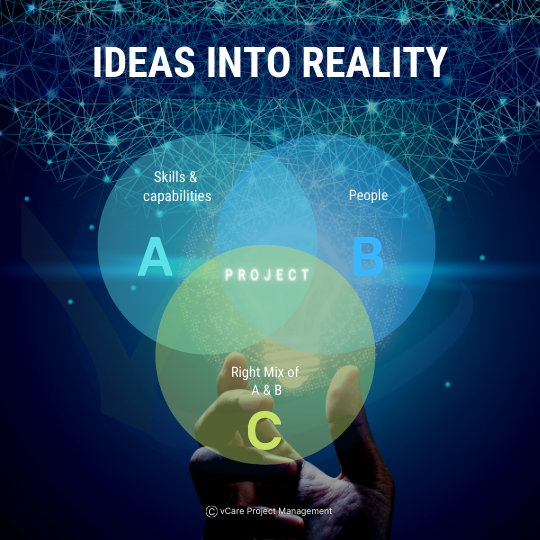
Ideas into Reality
The Project Economy at Work
The skills are utilized in project-based structures included in large organization’s portfolios and programs.
According to Professor and author Roger Martin, one of the world’s top-ranked management thinkers, this kind of approach is called “projectization,” where the everyday tasks become projects by themselves. Such trends are on the rise as “Gig Economy” is part of the project economy, which has been largely adopted by organizations like Ola, Uber, Airbnb, etc.,
People with varied skills, experience, and capabilities are brought onto one project to deliver value to the stakeholders. The resources are aligned at the portfolio level and mobilized to the projects on-demand based on priorities. Such an approach minimizes the cost of hiring, training, and retention. They all evolve into a high-performing workforce as they started merging into the socio-cultural aspects of the portfolio capabilities.

GIG ECONOMY
For example, companies like Zappos adopt a culture wherein the onboarded people or hired people are put onto their call centers to understand the various departments involved in the process and understand the pain they undergo. Post that, they will be able to get the context and core values of the organization, which were they can synchronize. It’s all about the task at hand than the title itself.
Vital skills in Project Economy
The Project Economy needs uniquely human skills such as leadership, creativity, and empathy.
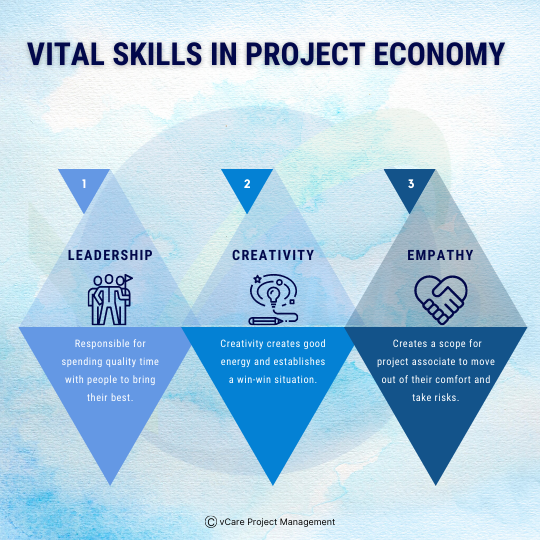
Vital skills in Project Economy
Leadership – Need to bring in the best of human potential. When the project economy is adopted, the people will move from role-based work to project-based work. As projects are going complex, a project manager is responsible for spending quality time with the people to bring their best.
Creativity – Creativity helps to find solutions to the problem in novel ways. Co-creation along with the stakeholders would minimize the postponement of decisions. It also extracts the thinking power of the participants creating new options. Creativity also creates good energy and establishes a win-win situation. Creativity can be fostered by providing an appropriate space to the team, decluttering the workplace, adopting a design thinking approach, etc… Foster an environment where creativity is recognized and rewarded
Empathy– When the project manager applies empathy, it creates scope for project associates to move out of their comfort zone and takes risks. It also brings on agility and helps reduces stress through minimized conflict. With empathy kindness and compassion becomes the natural ingredient promoting teamwork and leadership among individuals. Empathy can be exhibited by the project manager who is willing to be vulnerable and has the mindset to listen to all and exhibit leadership by walking the talk.
Project Economy Adoption
In the Middle East
There are many infrastructure projects already underway in the Middle East, such as Smart City, Higher Education, expansion of health care, etc… These projects bring changes to the digital infrastructure, transportation, and allied government service. Already in Dubai International Project Management Forum plays a vital role in megaprojects, including Construction of Digital Twin, Asset Project Management, BIM Implementation for Roads and Transportation Authority, Solar Park. All of these projects need people to execute. People are needed with the right skills to provide value to the stakeholders.
In the European Union
Case Study-1: Municipality located in Southern part of Sweden with more than 32000 inhabitants having organization size of 2400 full time and permanent employees have been organized as seven administrative departments. EU-funded projects were executed, and the projectification of departments, including public health, was achieved.
- The municipality has educated themselves and other organizations surrounding them, which helped effectively manage the EU funds and create competent project organization where employees make sense of their work.
- This move is transforming the civil servants, politicians to handle project activities affecting their organizing the style and overall impact on their performance routine.
- Implies changes where routines, or day-to-day activities, to an increasing extent are organized and understood, as if they were projects.
Case Study-2: Totally program worth 67.9 billion was allocated for the operational program through the EU. Territorial Self Government Units covering 57 offices were involved in a Survey related to identifying the benefits of Projectification
- Labor market institutions, up to 100% of offices declared that projects are never abandoned in the course of their lifetime
- In 96% of the projects, there was no change in the planned budget
- 89% of projects were completed according to the original schedule
- In 96% of the projects, there was no change in the planned budget
- Public organizations acting in this way make use of opportunities that arise in their environment, which proves their flexibility in adapting to changing conditions
- Changes in organizational structure are a temporary adaptation to the changes that have occurred in the external environment
Case Study-3: Automotive, Manufacturing, Engineering-Procurement-Construction (EPC), 2006 Football World Cup, Establishment of the Tsunami Early Warning System in South-East Asia.
- GPM study on projectification in Germany, almost 50% of working time in the manufacturing industry is spent on project work (GPM 2015)
- The project economy will generate 15% of value-added in Germany in 2020 (in 2007, it was 2%).
- The mean value shows that around 37% of all work processes in corporations are now organized in a project-oriented manner.
Summary:
As priorities change in these difficult times rapidly, project organizations need to embrace change. The Project Management office needs to build a team that commits to success. Project economy adoption is already a reality in various regions of the world. There are proven cases wherein successful projects are delivering values. Let’s focus on turning ideas into reality.
Feel free to check out my discussion on this topic with Dr. Reinhard Wagner in YouTube
You can subscribe and follow my podcasts and interviews with Project Management Experts on YouTube at https://bit.ly/2NDY8wd
You can subscribe to vCare Project Management YouTube Channel to catch future videos of our certification Q&A series and student success stories using the link https://bit.ly/2YF0wJl
For any questions related to Project Management career, training, and certifications, you can book an obligation free 15 minutes session with me by visiting talktodharam.com
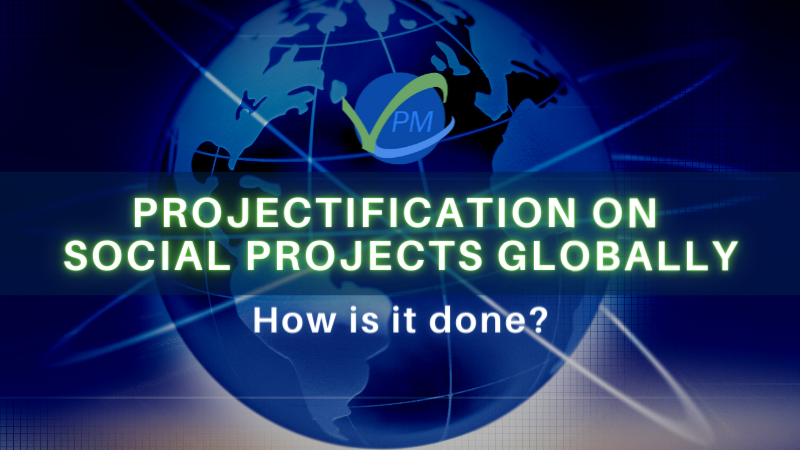
by DharamCW | Apr 26, 2022 | Project-Program-Portfolio Management Knowledge
- Implementing public policies through projects is driven through global organizations such as World Bank, UNICEF, UN, etc., encouraging projectification practices that drive down activities vertically deep down.
- Implementation and deployment of public policies are time-framed. Hence, they are projectified.
- Projectification is seen as a key strategic measure for getting things done concerning the EU.
- OpenPM² is a project management methodology designed by the European Commission for interoperability solutions for public administrations, businesses, and citizens.
- We introduce projects to the public sector managers’ toolkit in the smallest offices and teach how to build project portfolios in the largest public units.
- The Polish public sector used the external funds and started to fully “think project-wise.” Because projectification of activities was a “sine qua non” condition, none of the countries joining the EU structures can fully integrate with them if there are no competencies regarding project management.
- To receive and implement a project, people have to organize themselves into teams – so projects build micro-communities and unite people around a common goal, often involving stakeholders who have so far been excluded.
Models such as GPM3 can help manage the implementation and evaluation of projectification efforts and their maturity, as given in the figure below.

Governmental Project Management Maturity Model (GPM3®)
Governmental Project Management Maturity Model (GPM3®)
A maturity model is the sequence of groups (levels) of more efficient practices in any activity area. Our base area for defining maturity levels are Governmental Project Implementation and Governmental Project Management treated together as one system. The first source of our inspiration was Capability Maturity Model Integrated (CMMI ©) – probably the first widely recognized and probably best-known maturity model. The second source of inspiration was the Organizational Project Management Maturity Model (OPM3©) – a maturity model for the organizational level.
Initial Level
Some governments are (really!) not interested in managing their projects and investments. They think it is enough to allocate the budget and set the deadline for product delivery, and people will know how to do it. We say about such governments that they are at the lowest, Initial level of project management maturity.
Local Level
At some moment, people in individual governmental agencies and organizations, worried about continuous failures of their projects and inefficient work, learn that efficient and effective project management methods exist. After some time, they manage to convince their organization executives that it is worth implementing them throughout the organization. If project management methods are implemented only in some governmental organizations, we say that the given government has reached the Local level of project management maturity.
Governmental Level
After some time, the cabinet learns that a few of its projects (either internal or foreign governments) were implemented more efficiently than anywhere else. This awareness resulted in implementing project management methods, techniques, and processes to work in all government projects. This way, project management maturity in that state reaches the Governmental level.
Cooperating Level
But should the government only define the ways of project implementation and passively observe the results of these processes? It is better if the government is actively involved in implementing projects, like trying to solve problems faced by – usually complex and complicated – government projects. Then we say that governmental project management has reached the Cooperating level.
Optimizing Level
But this is not the end of the journey to the top of the ladder of maturity. Everything can always be done better (if there is such a need). The most advanced governments – such as the US Federal Government – command its ministries and agencies to improve project (and program) management processes constantly. Then we say that the given government has reached the Optimizing level of project management maturity. And this description of progressively achieved levels of project management maturity (which can be observed in some countries) is called the Government Project Management Maturity Model (GPM3®).

Think global, Act local
Think global Act local: Committed project management individuals are experts at acquiring funding and coordinating support for their solution. In terms of projectification, these characteristics of the project champion are skills that are disseminated and encouraged across local government organizations. These Project Managers need to have the skills to cut across culture, language and have the ability to influence the groups for projectification.
Involve in fieldwork to get closer
- Connect with the local people at the ground level and understand the ground situation better for such implementations.
- Observe in the meeting and participate in meetings based on the dynamics involved with civil servants in different departments.
- Be available at the field level to have empathy towards the problem in projectification.
The more you become closer to them, the better operational goodness.

Fieldwork
Projectifications impact on BaU (Business as Usual)
- Activities are organized and realized as projects.
- Projects are the new form of work and mechanism for change.
- Enforcing the way of projectification through regulations, framework, and practices
- Projects in the public sector impact governance and help adopt previous best practices.
- Helps to identify and pilot a new way of work
- Helps developing new strategies and shaping the future for the society through innovation and joint learning, and
- In some cases, organizations might use projects for dealing with controversial issues that the permanent organization does not want to deal with.
Conclusion
In the global setting, Projectifications provide organizations with the ability to link multiple business partners and respond quickly to market demand and supplier needs while remaining flexible enough to anticipate and respond to rapid shifts in consumer preferences. The positive impact has been proven, so countries and its government need to enable the Civil Servants to become better project management and program management professionals for seamless projectification. This move would lead to a better economy, GDP and generate an extraordinary value stream across the government services.
Feel free to check out my discussion on this topic with Dr. Reinhard Wagner in YouTube
You can subscribe and follow my podcasts and interviews with Project Management Experts on YouTube at https://bit.ly/2NDY8wd
You can subscribe to vCare Project Management YouTube Channel to catch future videos of our certification Q&A series and student success stories using the link https://bit.ly/2YF0wJl
For any questions related to Project Management career, training, and certifications, you can book an obligation free 15 minutes session with me by visiting talktodharam.com
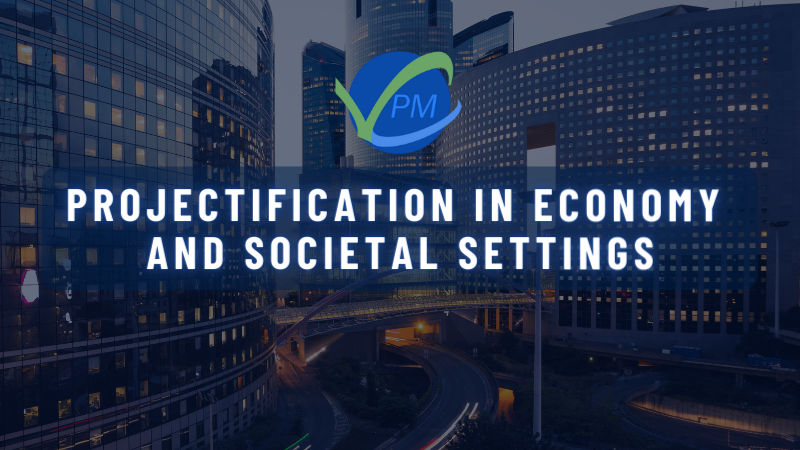
by DharamCW | Mar 29, 2022 | Project-Program-Portfolio Management Knowledge
In the public sector, as Mats Fred (2018, p. 189) indicates:
Projectification as proliferation emphasizes the increasing use and diffusion of projects and project ideas. Projectification as transformation and adaptation highlights the transformation of “permanent” ordinary organizational activities to temporary projects and processes of adaptation in the surrounding organizations and structures. Projectification as an organizational capacity building in which the project logic is spread and diffused in local government organizations, not primarily through specific projects, but through practices encouraging the project logic and reinforcing local government’s organizational project capacity.
The term “Project” itself would be considered as a temporary endeavor. Projectification involves the cultural and discursive societal processes whereby projects and project-like circumstances are institutionalized in individual lives, organizing all sorts of work and society. They are to be planned, controlled, managed with dedication and commitment. In a societal setting, it calls for flexible action and task-focused social relations.
Understanding the Societal Setting

Understanding the Societal Setting
When the boundaries of the project go beyond the organization, societal settings come into place. Societal settings focus on developing and providing solutions together. When the projects are managed and executed at the societal level, it becomes a more collaborative effort. This kind of environment calls for global communication, collective intelligence, identifying skills across the board to leverage. Project execution should focus on accomplishing the tasks by adopting agile principles with empowering the team. The focus should be working through the community via effective networking.
Factors that could affect projectification in societal impact
There could be an influence at a Project Level, Political, Bureaucratic and Market Level. To a varying degree, local government involved in the societal settings would have specific practices that correspond to a political, bureaucratic, and market context. In terms of projectification, there could be complementary or contradictory aspects in nature that need to be managed well. Projectification translation could be done based out on specific settings and practices.
The societal context would have to manage multiple institutions yet need to bring them with a common goal and vision despite indifferences. This aspect needs to be dealt with using Decoupling, Compromising, and Combining depending on the situation and environment. These practices will de-escalate tensions in arriving at a consensus on the focus area or goals.
The project budget needs to be derived from the policies wherein the costs are derived from the social investment funds. This action would mean cutting across the government and local bodies in the region. Sometimes these funds are advocated by World Bank, EU, IMF, etc… Using such funds would also call for strong coordination among the various stakeholders across different processes and procedures. Managing such funds could be tiresome and painful.
Be in the realm of the project in the implementation context. It would look like a smooth sail as initiation would be easy on the ground implementation could be a posing challenge. Focus on the welfare benefits, lower costs for the larger group during the implementation. Understand the potential areas of resistance early in the project upon the various factors including economic, environmental, etc.,
Projectification involves managing an organization to manage two types of complexity involving task complexity and Social complexity. Task complexity refers to the density of the units, causal links, and consequences within a temporal and spatial frame. Social complexity describes the number of members communicating and working with each other and the differentiation of their tasks. In contrast, cultural complexity encompasses the number of different historical experiences and sense-making processes confronting each other in a project.

Factors that could affect projectification in societal impact
The three projectification studies in Germany, Norway, and Iceland show that project work contributes to one-third of the national gross domestic product. Although differences exist among the countries regarding size and industry structure, the degree of projectification of advanced economies seems to converge on around one-third of all economic activities. The exact results showed that the share of project work in Germany was 34,7% in 2013, and 32,6% in Norway, and 27,7% in Iceland in 2014 (Schoper et al., 2018).
The projectification in the public or governance societal segment was more towards improving, modernizing the managerial approach towards the commoner or public. The projects were part of the public sector in the infrastructure area, such as Road Construction, Dam Construction, construction, and larger institutions, and their Projectifications are not sudden. Based on one of the research study by Schuster in 2015, he identified three key factors which seem to provide public/civil service organizations to adopt projectification. They are:
- Quick Mobilization
- Strategic approach towards managing the change
- Accountability and Transparency to stakeholders
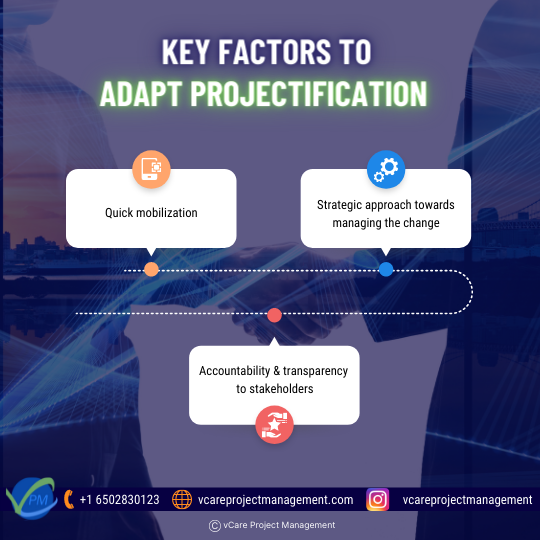
Key factors to adopt projectification
It is also to be realized that the ongoing social and economic change and the increase in public sector stakeholder’s innovation and entrepreneurship are most needed in this sector. Projectification helps to meet the void, which can help implement public policies, thus enabling changes in resolving social problems. Even though the benefits exist on projectification, it is not implemented due to the factors such as – Excess bureaucracy, Causes lack of trust, lack of persistence, etc.,
Conclusion
Projectification provides benefits to the people involved to know how to lead a team, influence people, and negotiate or resolve conflict. It would be a combination of more organizing activities to the organizations and transforming ordinary activities into projects. And increasingly, everybody needs to feel comfortable working in a digital environment.
Feel free to check out my discussion on this topic with Reinhard Wagner in YouTube
You can subscribe and follow my podcasts and interviews with Project Management Experts on YouTube at https://bit.ly/2NDY8wd
You can subscribe to vCare Project Management YouTube Channel to catch future videos of our certification Q&A series and student success stories using the link https://bit.ly/2YF0wJl
For any questions related to Project Management career, training, and certifications, you can book an obligation free 15 minutes session with me by visiting talktodharam.com






























Recent Comments